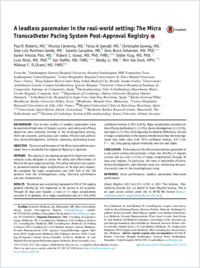A leadless pacemaker in the real-world setting: The Micra Transcatheter Pacing System Post-Approval Registry.
- Roberts PR Southampton General Hospital-University Hospital Southampton NHS Foundation Trust, Southampton, United Kingdom. Electronic address: prr@hrclinic.org.
- Clementy N Centre Hospitalier Régional Universitaire de Tours-Hôpital Trousseau, Tours, France.
- Al Samadi F King Salman Heart Center-King Fahad Medical City, Riyadh, Saudia Arabia.
- Garweg C Universitaire ziekenhuizen Leuven-Campus Gasthuisberg, Leuven, Belgium.
- Martinez-Sande JL University Clinical Hospital of Santiago de Compostela, Santiago de Compostela, Spain.
- Iacopino S Electrophysiology Unit, Arrhythmology Department, Maria Cecilia Hospital, Cotignola, Italy.
- Johansen JB Department of Cardiology, Odense University Hospital, Odense, Denmark.
- Vinolas Prat X Arrhythmia Unit, Hospital de la Santa Creu i Sant Pau, Barcelona, Spain.
- Kowal RC Baylor Scott and White Healthcare, Baylor University Dallas, Texas; Medtronic, Mounds View, Minnesota.
- Klug D Centre Hospitalier Régional Universitaire de Lille, Lille, France.
- Mont L Hospital Universitari Clínic de Barcelona, Barcelona, Spain.
- Steffel J Universitats Spital Zürich, Zürich, Switzerland.
- Li S Medtronic, Mounds View, Minnesota.
- Van Osch D Medtronic Bakken Research Center, Maastricht, The Netherlands.
- El-Chami MF Division of Cardiology, Section of Electrophysiology, Emory University, Atlanta, Georgia.
- 2017-05-16
Published in:
- Heart rhythm. - 2017
Acute performance
Leadless pacemaker
Real-world performance
Aged
Arrhythmias, Cardiac
Cardiac Catheterization
Device Approval
Equipment Design
Female
Global Health
Humans
Male
Morbidity
Pacemaker, Artificial
Prospective Studies
Registries
Treatment Outcome
English
BACKGROUND
First-in-man studies of leadless pacemakers have demonstrated high rates of implant success, and safety and efficacy objectives were achieved. Outside of the investigational setting, there are concerns, particularly over cardiac effusion and perforation, device dislodgement, infection, telemetry, and battery issues.
OBJECTIVE
The acute performance of the Micra transcatheter pacemaker from a worldwide Post-Approval Registry is reported.
METHODS
The registry is an ongoing prospective single-arm observational study designed to assess the safety and effectiveness of Micra in the post-approval setting. The safety end point was system- or procedure-related major complications at 30 days post implant. We compared the major complication rate with that of the 726 patients from the investigational study. Electrical performance was also characterized.
RESULTS
The device was successfully implanted in 792 of 795 registry patients (99.6%) by 149 implanters at 96 centers in 20 countries. Through 30 days post implant, a total of 13 major complications occurred in 12 patients, for a major complication rate of 1.51% (95% confidence interval, 0.78%-2.62%). Major complications included cardiac effusion/perforation (1, 0.13%), device dislodgement (1, 0.13%), and sepsis (1, 0.13%). After adjusting for baseline differences, the rate of major complications in the registry trended lower than the investigational trial (odds ratio, 0.58, 95% confidence interval, 0.27-1.25; P = .16). Early pacing capture thresholds were low and stable.
CONCLUSION
Performance of the Micra transcatheter pacemaker in a real-world setting demonstrates a high rate (99.6%) of implant success and low rate (1.51%) of major complications through 30 days post implant. In particular, the rates of pericardial effusion, device dislodgement, and infection were low, reinforcing the positive results seen in the investigational study.
First-in-man studies of leadless pacemakers have demonstrated high rates of implant success, and safety and efficacy objectives were achieved. Outside of the investigational setting, there are concerns, particularly over cardiac effusion and perforation, device dislodgement, infection, telemetry, and battery issues.
OBJECTIVE
The acute performance of the Micra transcatheter pacemaker from a worldwide Post-Approval Registry is reported.
METHODS
The registry is an ongoing prospective single-arm observational study designed to assess the safety and effectiveness of Micra in the post-approval setting. The safety end point was system- or procedure-related major complications at 30 days post implant. We compared the major complication rate with that of the 726 patients from the investigational study. Electrical performance was also characterized.
RESULTS
The device was successfully implanted in 792 of 795 registry patients (99.6%) by 149 implanters at 96 centers in 20 countries. Through 30 days post implant, a total of 13 major complications occurred in 12 patients, for a major complication rate of 1.51% (95% confidence interval, 0.78%-2.62%). Major complications included cardiac effusion/perforation (1, 0.13%), device dislodgement (1, 0.13%), and sepsis (1, 0.13%). After adjusting for baseline differences, the rate of major complications in the registry trended lower than the investigational trial (odds ratio, 0.58, 95% confidence interval, 0.27-1.25; P = .16). Early pacing capture thresholds were low and stable.
CONCLUSION
Performance of the Micra transcatheter pacemaker in a real-world setting demonstrates a high rate (99.6%) of implant success and low rate (1.51%) of major complications through 30 days post implant. In particular, the rates of pericardial effusion, device dislodgement, and infection were low, reinforcing the positive results seen in the investigational study.
- Language
-
- English
- Open access status
- hybrid
- Identifiers
-
- DOI 10.1016/j.hrthm.2017.05.017
- PMID 28502871
- Persistent URL
- https://folia.unifr.ch/global/documents/47569
Statistics
Document views: 18
File downloads:
- fulltext.pdf: 0
